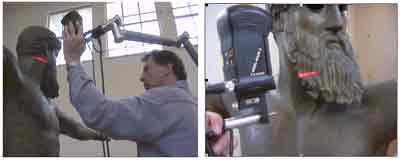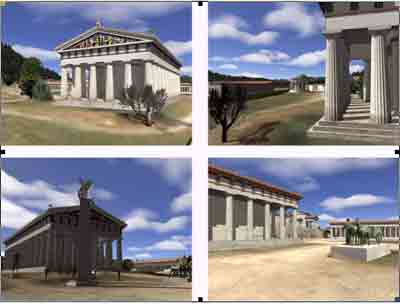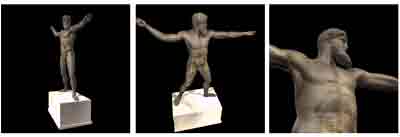Cliff Ogleby
Department of Geomatics
The University of Melbourne
Victoria, 3010, Australia
E-Mail: [email protected]
Abstract
In conjunction with the Sydney 2000 Olympic Games, and the associated Cultural Olympics, the Museum of Applied Arts and Sciences (also known as the Powerhouse Museum) is hosting an exhibition 1000 Years of the Olympic Games – Treasures of Ancient Greece. Two integral components of this exhibition were virtual reality based displays, one on the reconstructed ancient city and another on the Statue of Zeus/Poseidon from the National Archaeological Museum in Athens.
This paper will present the techniques and experiences used in the production of a 3d immersive narrated tour of the ancient city, and the development of the associated material for presentation on the Internet. It will also detail the approaches undertaken to digitise the Statue of Zeus using an hand held laser scanner, and the processing of this data into a high resolution model suitable for interactive display. It will cover the exhibition design process, and the technology employed to give museum visitors a 3d experience of the ancient environment of Olympia.
The project has received substantial media coverage, and the exhibition has also been short-listed for a BAFTA award for the associated web site, and has won the best virtual world heritage award at the VSMM conference in Japan.
Introduction
The advent of the Sydney 2000 Olympic games in Australia was an occasion for celebrations and festivities of many different kinds, as well as the sporting event itself. In conjunction with the athletic events there were cultural events, ranging from classical and contemporary dance through art displays and including the 1000 Years of the Olympic Games – Treasures of Ancient Greece exhibition at the Museum of Applied Arts and Sciences. This Exhibition showcased antiquities loaned from the Hellenic Ministry of Culture that depicted Olympic sporting events, and incorporated two virtual reality components.
Project Overview
The subject of this paper is the preparation of the virtual reality data used in the two VR exhibits. This consisted of a re-creation of the site of the ancient games, Olympia, and a high resolution digital model of a statue from the Museum of Antiquities in Athens. In addition, this paper will discuss the methods used to present this material to the public as part of a curated museum exhibit.
Project Elements A: Ancient Olympia
Olympia is located between the Cladeus and Alpheios rivers on the western side of the Pelloponese. It is an archaeological site, where most of the monuments lie scattered as a result of two earthquakes and numerous floods over the centuries. The foundations that survive from many of the buildings date to different periods, from the Archaic, Classical, Hellenistic and Roman times.
Olympia became the primary site for the games held in honour of Zeus, and with the rise of Zeus through the pantheon of Greek gods the games at Olympia increased in importance. The game were a time of peace throughout the Hellenic world and an occasion for displays of sportsmanship and athleticism. The games were also a time for business deals to be struck, war booty to be displayed, and state and city honour to be upheld. Following the Roman rule of the Hellenic world, and the rise of Christianity, the games diminished and eventually the site was abandoned.
Excavations at Olympia were begun in May 1829 by French archaeologists, who transferred many of the finds to the Louvre where they are still being exhibited. When the Greek government was informed of the looting of artefacts, the excavation was stopped. Excavations started again 45 years later by German archaeologists, which continues to this day. Much of the material published as a result of the excavations formed the basis of the reconstructions used in this project (Adler, F. et al, 1892-1897/1966).
Project Elements B: The Statue of Zeus/Poseidon
One of the most significant sculptures in the National Archaeological Museum in Athens is the statue of Zeus from Artemision (Artemesium), also considered to be perhaps a statue of Poseidon. This bronze sculpture is slightly larger than life size, and was found in 1926 in the sea off Cape Artemision (hence the confusion about which brother the statue represents). It is one of the few surviving examples of Early Classical statuary, and represents the deity as a perfect human form.
It is presented in the Museum in Athens on a pedestal, in a sunlit room with other statuary around the walls.
Data Gathering:
The two exhibitions required considerable data to be collected before any modelling could commence. Much of this data was of a dimensional nature, but additional information on the types of materials used, the colouring of architectural elements, the terrain of the period, vegetation and so on was also needed.
The Statue of Zeus/Poseidon
In order to develop a high resolution digital ‘copy’ of the statue of Zeus it was decided to use state-of-the-art reverse engineering techniques. This approach would enable a dense three dimensional coordinate data set to be acquired within the minimum time possible.
A Modelmaker Laser Scanner mounted on a Faro 3D Coordinate Measurement Arm was used to create high resolution point clouds of the surface of the statue. A purpose built scaffold was fabricated in Athens to give the facility to elevate the scanner in order to access the top of the statue whilst also ensuring a stable fixture. The entire sculpture was digitised over several daytime sessions in multiple parts. There were considerable restrictions on this part of the project (including initially no photography, essential for material maps), no method or re-orienting the scanning system datum, and a very short working period in the Museum. These hurdles created complications in the data stitching process as each scan was effectively an independent data set with no points in common other than overlapping surfaces.
Figure 1: Scanning the Statue of Zeus/Poseidon
The Site of Olympia
The topography of the site and the locations of key structures were also surveyed by members of the team so that the present surface (which approximates the original ground level of the site) could be used in the visualisations. This was performed using topographic surveying equipment loaned by the National Technical University in Athens.
A digital elevation model was prepared from this data, and combined with a detailed terrain model of Kronos Hill obtained from large scale topographic maps. In addition, the surrounding landscape was also modelled from smaller scale topographic series maps. As a result of the merging of these 3 data sets, the landscape of Ancient Olympia used in the visualisations is a very close approximation to the terrain of the period.
Architectural and Sculptural Elements
Olympia was not used as a ‘city’ as such, it was first and foremost a place of worship, and a place for the celebration of the games held in honour of the Gods. Many of the structures on site were temples, with a few administrative and special accommodation buildings. In 200BCE, there were buildings at Olympia from most of the main architectural periods, dating back to around 700BCE. The date of 200BCE was chosen as the epoch was indicative of the evolution of the site, but without the more recent Roman additions.
Information on the architecture was obtained mostly from the publications of the German archaeological expedition, and from Pausanias, a travel writer of the first Century AD (Levi, 1979)
Generation Of The Elements
The reconstruction of ancient Olympia has been a long and involved process. At all times effort was made to create models and materials that were not only visually appealing but also historically correct. A multitude of published sources were consulted in order to determine the architecture of the missing buildings, the form and colours of the decoration, the statues, the terrain features and vegetation. All of the architectural elements have been built as close to their ‘original’ descriptions as possible.
The original building models were created in Bentley System’s MicroStation CAD package, primarily because of the level of experience with this package and its suitability for precise dimension control. This caused many difficulties when translating data into the 3d modelling package used, the only common workable export format was DXF which not only gave considerable errors in relative position of elements but also created very large polygon counts for even simple objects. Much of the building elements were re-created in 3d Studio Max from scratch.
All of the structures are in the locations derived from the archaeology of the site, and are true to scale in all dimensions. The heights of the buildings were derived from the architectural remains, and were extracted from the publications. The materials and textures were composed of colours derived from the archaeological and historical record, as well as using contemporary materials typical of the period. The descriptions of the buildings and statues by Pausanias were also used as the basis for much of the material mapping, and for the style and location of the statuary.
Figure 2: Postcards from Olympia
All of the animations were created using 3d Studio Max. Consideration was given to using a variety of other packages however the ‘render-farm’ facility of 3d Studio Max offered substantial (essential) time savings. The render-farm finally consisted of approximately 60 machines, ranging from very fast Pentium PIII to PII computers. Whilst the render-farm required considerable nurturing the process greatly facilitated the delivery of the exhibition in a very short time period.
The rendering consisted of 14 animation sequences timed to fit the narration, created as single left and right channel frames for later composition and post production, in excess of 40,000 frames.
Production Of The Exhibitions
3-D Zeus
The Zeus model was presented in a separate 3d virtual reality booth at the Exhibition. It was displayed using shuttered glasses technology (they were suspended from the roof), driven by proprietary software running on Intergraph hardware. The use of shuttered glasses necessitates the presence of a museum attendant, this option was not pursued for the reconstruction of the city which used polarised projection. The model was rendered in real-time, and was displayed at life size on one screen and as a close-up of the head on another.
A limited amount of interactivity was provided where users could rotate the model about its vertical axis, and zoom in and out. It was not possible to flip the statue, this was seen to be disrespectful.
Figure 3: The Statue of Zeus/Poseidon virtual model
Virtual Olympia
The 3d experience offered to visitors was developed in Macromedia Director using a ‘stage’ that was 1600×600 pixels. The two separate 768×576 (PAL) animations sequences that made up each tour path were composited into one 1536×576 movie, ensuring perfect synchronisation between the left and right channels. These animation sequences were then used in Director, where the interactivity and additional material was added. Visitors to Ancient Olympia would be guided through the site along pre-determined paths, accompanied by a narrative explaining the monuments with anecdotes of life in during the games
Two JVC DLA-C15 rear projection capable projectors were used to overlap the left and right channel images onto a 4m wide screen in a 5m square room. A custom built console was designed to facilitate user interaction at the decision points, and mounted on a stand approximately 3m from the screen. The computer used to deliver the movies was a 2x800MHz Pentium III machine, with 500Mbyte of RAM, fast disk access and a Matrox G400 graphics card. This card has a twin screen output of 800×600 resolution, which was used to drive the two projectors.
The Supporting Website
The primary sponsor of the VR exhibitions required a web site be developed to support the exhibition, and to brand the digital components with their corporate presence. The web site was very successful, earning a nomination for a BAFTA (British Academy of Film and Television Arts) award, and receiving an AIMA (Australian Interactive Media Association) Best Web Site award.
The web site contained, amongst 4Gb of material, LivePicture format panorama of the reconstruction, with linked ‘hotpoints’ and the narration. In addition, the Statue of Zeus was presented as a 2d LivePicture animation, and as a 3d anaglyph version. The web site also contained a downloadable file for the preparation of 3d anaglyph glasses on a colour bubble jet printer.
Conclusion
The exhibition was an outstanding success, with most visitors to the VR displays staying for the entire 20 minute presentation. The web site held the visitor’s attention, with 12% of the visitors staying on-line for 20 minutes or more. The project represents a melange of scientific research and data acquisition techniques presented to the public as entertainment and education, using state-of-the-art 3d computer graphics.
Acknowlegements
This project was made possible through the generous provision of the Hellenic Ministry of Culture (https://www.culture.gr). A number of people in the Ministry worked hard on our behalf to make the data collection process possible. Sponsorship to complete the work was generously provided by the Intel Corporation (https://www.intel.com). Thanks also to the Australian Ambassador in Athens, Ross Burns, and consul Deborah George, to Jan Casson-Medhurst at the Australian Archaeological Institute at Athens, Judith Swaddling at the British Museum for her time in reference to the scale model of Olympia housed at the Museum. The website was conceived by the Powerhouse Museum (https://www.phm.gov.au) with graphic design by Massive Interactive ). The photographic work at the archaeological site was undertaken by Peter Murphy, Sydney. It is his genius also that enabled much of the data that is displayed on the web site. The overlays for the metopes were draw under the direction of Kate Da Costa by a meticulous and hardworking David Loong.
References:
- Adler, F., Curtius, E., Dörpfeld, W., Graef, P., Partsch, J. & Weil, R. 1897/1966 Olympia I: Topographie und Geschichte, Amsterdam
- Adler, R., Borrmann, R., Dörpfeld, W., Graeber, F. & Graef, P. 1892/1966 Olympia II: Die Baudenkm







